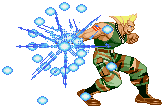|
||||||
|
[ updates ] [ articles ] [ media ] [ notebook ] [ gallery ] [ links ] [ help ] [ contact ] |
SF Combo System Interpretation
By Maj Whenever fighting game developers unveil a newly designed combat system, the player community responds by unleashing a continuous campaign of rigorous exploration. Tournament veterans seek out dominant techniques to give themselves a competitive edge, while technical specialists work toward documenting every nuance they can find. As players collectively and individually explore the depths of this concealed game engine, boundaries are successively discovered, tested, and redefined. From the perspective of a fighting game enthusiast, one of the most astonishing phenomena to witness is the gradual evolution of a combo system. Each title, combined with the circumstances surrounding its release, produces a unique development cycle. Yet many grand scale growth patterns persist more or less universally. It may seem odd to envision finalized software continuing to develop after leaving its manufacturers' hands, but it's impossible to deny the players' impact on the way a game is played. In many cases, it only takes a couple of months for the result to become all but unrecognizable to the original designers. Emergence Naturally, the initial wave of combo video releases represents basic comprehension - wherein it's all about defining boundaries by reproducing what the game designers had in mind. Much of this phase leans heavily upon exploiting similarities with previously mastered predecessors. Nearly every nascent combo falls into one of two categories: those which mimic concepts executed in another game or those which illustrate an obvious facet of a newly introduced maneuver. In hindsight these pioneering endeavors will resemble glorified instruction manuals, yet their popularity never falters because their content remains accessible to newcomers. In order to advance beyond this stage, someone has to step up to the responsibility of breaking down the game system's rules and inner workings for the entire community. Hence, when jchensor writes one of his comprehensive guides, it marks the end of amateur hour and forces everyone to think outside the box. Transformation Once a game's maturity starts to show, the focus shifts to creating combos which the game designers had never dreamt of. This process involves compiling setups, amassing technical knowledge, and sharing discoveries until enough elements accumulate to make some magic possible. Before long, the true character of the game begins to take shape. Combos can become progressively glitchier as players find consistent ways to reproduce convenient bugs. Constant refinement eventually leads to magnificent breakthroughs, difficult to trace back to any discernable origin. It's during this period that the game's lasting identity is finally revealed. It's important to understand that none of these achievements would be possible without extensive community interaction. No single person can match the sheer time output of a thousand. That said, there does come a point when the skill and expertise necessary for genuine innovation exceed the abilities of everyone except combo specialists. Beyond this threshold, all of the shortcuts for finding unknown combos cease to exist, leaving only dedication. Culmination As any popular game ages, exhibition video content grows more and more refined in production. For example, if a certain combo works against Zangief and Balrog but not Ryu, it might take a year for anyone to demonstrate it against Balrog. Early on, everyone constantly defaults to the fattest available victim and moves on. Novelty is simply too accessible to worry about finding the thinnest punching bag for each individual combo. Breaking up the monotony of combo dummy selection is one of many stylistic issues that nobody considers a priority at first. In the beginning, every significant discovery carries an urgency for publication tied to the suspicion that someone else may find it too. The longer it has been since the game's release date, the more lenient this aspect becomes. Of course, there's always a tradeoff. While working on an old game, there's less pressure from competition but it's more time consuming to find anything original. Adding a deadline can cause a lot of extra stress, but sometimes it's worth it just to keep a project on track.
Optimization plays an increasingly central role in the creative process. Suddenly that solitary extra hit seems like enough reason to rebuild the entire sequence from the ground up. Ultimately, two minutes of fresh material starts taking weeks to cultivate. By this point, most combo video makers have given up on the game and new releases rarely see the light of day. Still, there's always room for something more and it's always exciting when someone accepts that challenge.
|
|||||



